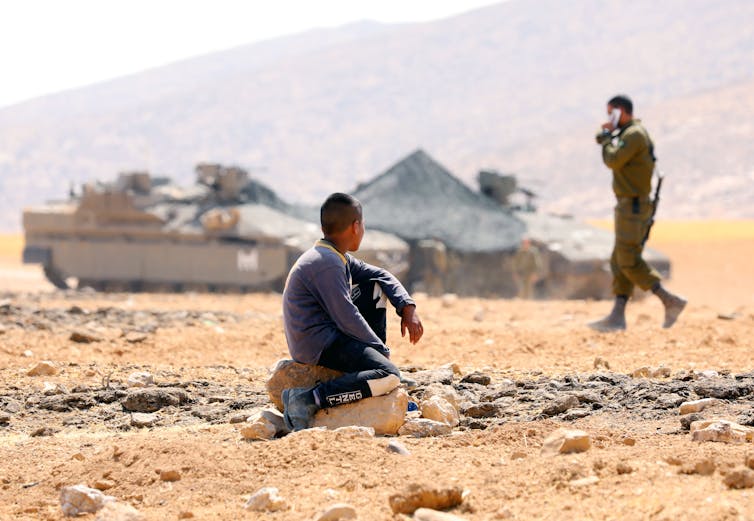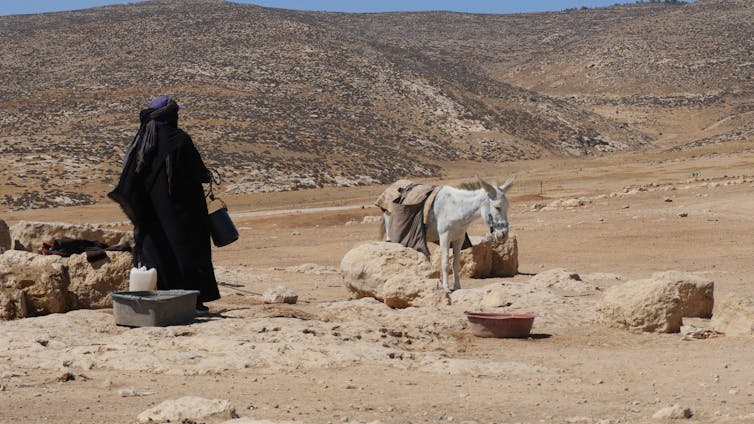The people of Masafer Yatta are determined to hold on to their cave-dwelling lifestyle. “I was born in this cave and gave birth to all 12 of my children here,” says Hajja Halima Abu Younis, an 82-year-old woman from Jinba, one of 33 villages in this semi-desert region at the southern tip of the occupied West Bank.
Masafer Yatta is the only Palestinian territory where many caves are used as homes – some 200 of the 800 caves in this area are still inhabited. Abu Younis says she would never accept another home even if the Israeli government offered her a house with two floors. She can trace her family’s history in this cave back almost two centuries:
Mahmoud Ahmad, the grandfather of my husband, was born in this cave back in 1840. My husband’s father was born here in 1906, then my husband and now my sons. We were two families sleeping here: my husband and me on this side, my brother-in-law on the other. All our children were sleeping in the middle.
In 1980, Israel ruled that a large section of Masafer Yatta including 12 villages was, in fact, uninhabited. It designated the land Firing Zone 918 – an area for its military to practise with live ammunition. The residents of these villages remained until 1999, when the military attempted to evict more than 700 Palestinians on the grounds that they were “illegally living in a firing zone”. These families have been fighting a legal battle for their communities’ right to remain ever since, which was finally rejected by Israel’s Supreme Court in May 2022.

This story is part of Conversation Insights
The Insights team generates long-form journalism and is working with academics from different backgrounds who have been engaged in projects to tackle societal and scientific challenges.
Since that ruling, the Israeli military has carried out regular live ammunition practices in and around eight villages within the zone. It has also escalated the forced evictions of local residents including those living in caves. Virtually all structures within Firing Zone 918 are now without legal protection against demolition.
Abu Younis says the most significant threat to the locals comes on the three days each week, Monday to Wednesday, when military training takes place:
In these days we are jailed in our caves, we cannot move. We are afraid the Israeli army will kill someone while they are conducting military training. The army trains tanks around our village. The sound of the bombs and shots scare the children and the flocks of animals. My son Issa cannot graze his 150 sheep during the military training. How can a shepherd be a shepherd if he cannot graze his sheep?

Abed Al Hashlamoun/EPA-EFE
‘We feared nothing but the wolves’
The different styles of cave in Masafer Yatta reflect changing lifestyles from one generation to the next. Some possess water wells and tunnels so that residents could keep, feed and wash their farm animals inside the caves. Others have moats around them for external feeding.
Mohammed Abu Sabha, an 84-year-old farmer and shepherd originally from Al Quarytein village, is taking a younger generation of Palestinians aged 19 to 29 to see the cave in which he was born. Down narrow, crumbling stone steps, the group enters a large underground area with a low, domed ceiling. Abu Sabha is overcome with the emotion of his childhood memories as he steps into the cave:
Oh my god, it has changed. Why is it destroyed like this? I need to come back and renovate it. This cave means everything to me – I was born in it and I want to die in it too.
Abu Sabha’s family was evicted from the cave in 1951 when he was 13 years old. He has not been back in many years (he now lives in Yatta city, the urban centre north of Masafer Yatta). When he was a child, it was home to four families who all slept in the same room. Cows and camels lived inside the cave too to keep them safe; the cows were used to plough the surrounding land that provided the families with their main source of income. As one of the young visitors puts it: “Camels and sheep back then were like the Mercedes cars of today.”
Since 2017, researchers at Coventry University have been working with a younger generation of Palestinians from Masafer Yatta to gather stories from their elders. The On Our Land project was established to build oral histories of what everyday life was, and remains, like for the semi-nomadic people who call this part of the occupied West Bank home. We have been given access to historical documents, testimonials, historical maps and photographs to support these oral histories.

Mahmoud Makhamra, Author provided
Abu Ashraf Hamamda, a 60-year-old farmer who still lives in a cave in Al Mufaqara, one of the villages inside Firing Zone 918, explains how people used to move around Masafer Yatta following annual cycles of harvest, livestock grazing and rest:
We used to live from October to July in the lower parts of Masafer Yatta. In summer, we would move to the hills to harvest our rain-fed produce of grapes and figs … The whole family participated in harvesting, everyone who could carry a sickle – old and young, men and women. We took food with us, grapes and milk from the sheep. We worked all day, morning to evening … We stayed in the fields for two weeks without coming back to the village.
At this point, he starts singing the song they would all sing while cutting the wheat: “Oh my sickle with the sharp teeth. Oh my sickle that is made in Gaza.”
According to Ali Na’ameen, a 73-year-old shepherd from Al Majaz village, the sheep’s milk they produce is unique because of the area’s particular geography:
In Masafer Yatta, we do not have as much rain as in the north [of the West Bank]. But the grass here is the best because it is salty; it strengthens the sheep’s immune systems. This gives their milk a creamier texture and makes it more nutritious.
Na’ameen is usually a happy soul, but as he talks he grows nostalgic for a more carefree time:
My favourite moments in summer were when shepherds gathered in the middle of the day around the water well. From late morning until early afternoon, the sheep had naps because of the hot weather. We took this time as an opportunity to chat. Sometimes, we played games such as the “seven stones and fence” game, which is a bit like chess. We were happy and had peace of mind. We feared nothing but the wolves coming for our sheep.
‘A piece of paradise’
Masafer Yatta sits at the southern tip of the West Bank’s South Hebron Hills. Its craggy mountains and hills resemble walnut shells in summer, connected by more fertile pastures in the valleys below. About 3,000 people live here, mostly working as shepherds and farmers growing wheat, barley, beans and olives.
The locals tell us different stories about the name of the area. Some say Masafer comes from the Arabic word for “zero”, referring to the belief that life could not thrive in this hot and harsh landscape. However Nidal Younis, the current mayor of Masafer Yatta, tells us it refers to the last period of the Ottoman Empire, when locals were freed from paying taxes for agricultural products in order to win their loyalty to the weak Ottoman rulers.
Yet another version suggests Masafer means “travelling”, referring to the journeys people have long been making through this area – including traders and pilgrims travelling between Africa, Asia and Europe. Abu Younis describes how the villagers used to give these travellers food and fresh water from a pond, filled by an ancient clay pipe running down from a spring in the hills.
People have lived on this land for many generations, grazing sheep and goats and selling dairy and livestock products. According to the mayor, however, many feel they cannot sustain themselves and their families solely through subsistence farming and shepherding any more. “In the past,” Younis says, “we were cultivating huge areas so you did not need to think of alternative [sources of income], despite the hardship of this life.”
Read more:
Heritage as resistance: young people in occupied Palestinian territory are using their past to protect their future
In recent decades, many younger Palestinians have gravitated away from the rural lifestyle to Yatta city and beyond. Ibrahim Nawaja, who is from the village of Susya and splits his time between Susya and Yatta city, says rural Masafer Yatta is “like a piece of paradise for me, with its fresh air, calm atmosphere and rich nature – green in spring, yellow in summer. I come here to get away from the traffic and noise of the city.”
But the land designation changes applied by Israel since 1980 have disrupted the traditional lives of farmers and shepherds here. Nawaja suggests that while this semi-nomadic lifestyle was never easy, the additional barriers imposed have made it much harder – and residents’ testimonies have repeatedly alleged that Israeli settlers have exacerbated tensions by interfering with water supplies and through other attacks.
People’s lives have become difficult and complicated because of the occupation’s restrictions. There are many injustices, including when our water wells and pastures have been contaminated.
A ‘misunderstanding’ that changed everything
Many residents tell us the declaration of Firing Zone 918 rests on a misunderstanding. They say the Israeli government did not recognise that the people of Masafer Yatta live a semi-nomadic lifestyle when it first deemed the area uninhabited in 1980. More than four decades later, this position was endorsed by Israel’s Supreme Court in its May 2022 final ruling, which found that Masafer Yatta residents had no right to the land because they were not permanent residents at the time of its declaration as a firing zone.
In August, the Supreme Court rejected a further appeal from residents against the demolition of two schools and other Palestinian buildings within the firing zone. Yesterday (October 2), the court rejected a request for a further hearing on its May 4 verdict, and Israel’s government confirmed it would not grant any more court hearings.
When the Oslo Accords were signed in the early 1990s as a step towards fulfilling the right of the Palestinian people to self-determination, Masafer Yatta was categorised as “Area C”, meaning it still fell under full Israeli administrative and military control. Prior to 2022, the biggest displacement of residents took place in 1999. Abu Ashraf Hamamda recalls how he reacted to that eviction:
After they collected our belongings and threw them to the other side of the road, I snuck through the mountains back to my village. I contacted Israeli activists and lawyers. I went to the Israeli parliament, and gave a speech about the right of my people to stay in our villages and that we had been living there for a long time. After four months, we had a court decision that allowed us to return and to stay temporarily. And we repaired our communities.
More than two decades on from the eviction, they are still living there – and, says his wife Um Ashraf Hamamda, their determination to remain is stronger than ever:
We are eight big families in this village. Our grandparents and our parents lived here … The occupation expelled us to Al-Tuwani village. They threw away our belongings, they dispersed us [but] we persevered. We sued them and kept striving until we reached the Supreme Court … Then when we returned to our village, the occupation continued oppressing us because they failed to expel us the first time. They poisoned our cattle so we would lose hope and leave the village. But we stayed – we did not leave! We were born here and we have to stay here.
Most of the 700-odd residents evicted in 1999 returned to their caves and other buildings after the court’s decision in March 2000. The ruling allowed the residents to return temporarily – and they have been fighting a legal battle with Israel ever since.
In recent months, however, the Israeli military has stepped up the demolition of buildings within the firing zone on the grounds that Palestinians have no permits for them. Such permits are extremely hard to obtain from Israel’s government.
Residents say they are prevented from having electricity with any solar panels they erect soon being destroyed. They have also described the authorities cutting water pipes, demolishing wells and confiscating water tanks in order to deprive them and their animals of water.
The threat of settler attacks
The threat to the livelihoods – and existence – of Palestinians in Masafer Yatta also comes from the building of Israeli settlements on land at the edge of Firing Zone 918. This land was previously used by Palestinian farmers and shepherds, who now find themselves “boxed in” between military training and the new settlements.
The settlers are all Israeli citizens of Jewish descent who have moved into gated communities in this occupied Palestinian territory. Housing in such settlements is often subsidised by Israel’s government, and different laws apply to these settlers than their Palestinian neighbours.
Settlers are widely reported to have inflicted harm on Palestinian residents of Masafer Yatta, including by the UN’s Office for the Coordination of Humanitarian Affairs. Some residents tell us that on occasions, they have seen their water supplies being contaminated by settlers living close by. According to Abu Ashraf Hamamda:
Since Israel started building the settlements, we now live less than one mile from them. Settlers chop our trees, burn our crops and poison our water wells … In the past when we were herding our sheep, we moved freely in our land and slept wherever we wanted. But today we do everything very quickly because we want to avoid settler attacks.
Experiences of settler-instigated violence come up regularly in the oral histories we have recorded. Hajja Nuzha Al-Najjar describes how, in 2005, she was in a field with her daughters-in-law when she was shot in the back of her leg by some Israeli settlers. Her leg is stretched out in front of her as she recalls that “my son was on the other side of the valley. When he tried to join me, he also became a target so had to crouch down and hide.”
Al-Najjar limped back to her cave and only then realised the blood was streaming down her leg. An ambulance was called but the settlers would not let it pass, she recalls, so she had to be bundled into a car and driven some way before she could be transferred to the ambulance.
The level of livestock in Masafer Yatta is now just a third of what it was in 1980 when the firing zone was first declared. Abu Ashraf Hamamda explains the reasons for this decline:
On the one hand, we cannot reach the places we used to herd in. On the other, since Oslo [the signing of the Oslo Accords], the price of animal food has increased. In less than six months, barley and wheat prices increased by 80% – I could not afford that for my sheep … We were forced to sell part of our livestock because we were unable to feed them.
While our interviewees acknowledge the support they receive from many international and national humanitarian aid organisations – including being supplied with animal food – they say this is not a desirable solution. As Ali Na’meen explains:
Today we are receiving barley from the Food and Agriculture Organisation, a UN agency, instead of producing our own crops as in the past. We graze our sheep in groups, accompanied by international volunteers to protect us … This is not the kind of life we used to have when we moved freely and produced our own food. Despite that hard life, we were still in a much better situation than we are now.
‘I need to see my future’
The traditional semi-nomadic lifestyle of this area is also threatened by societal and cultural changes from one generation to the next. Most of the elders here say that young Palestinians want to live in houses, have smartphones and secure jobs rather than following the tough path of farming and shepherding. As a result, many have moved to Yatta city in the north-west of Masafer Yatta. Others have moved to cities such as Hebron, Bethlehem and Ramallah to study or work. Somia Al-Omour, one of the project’s young researchers, explains:
I need to see my future and live a normal life. I decided to continue my education in Ramallah as a nurse and to work there. I would not have the same opportunity if I stayed in Masafer Yatta.
In contrast, the elders of Masafer Yatta are more determined than ever to remain living in their caves and maintain their lifestyles as farmers and shepherds. But Abu Ashraf Hamamda accepts it is difficult to convince young people to carry on with this lifestyle:
Some of them are fed up living in the caves. They want to sleep in bedrooms, and they want a shower. They dream of having a closet for their clothes, not just a bag to put them in.
The unique traditions associated with life in the caves of Masafer Yatta may have lost some of their significance for the younger generation. Yet through our oral histories, we have seen bonds strengthen between the different generations. Khalil Makhamrah from Jinba village describes the profound impact of interviewing his grandmother:
That interview changed my perspective about the elderly people here, about the importance of their stories and lives. Ploughing the land was difficult for them but [I learnt] how much they enjoyed it. This is really important. When we can bring a tangible item from our past forward, it proves we own this land and it brings us closer to it. We need to protect this land that has been inherited to us, because this is the life of our parents and grandparents.
Such discussions may demonstrate to the next generation of Palestinians the value of “sumud” – steadfastness – in an area that is increasingly at risk. Ironically, the current threat of military practice within Firing Zone 918 is making young people return to the caves with their parents in greater numbers, as Taha Al-Omour, another of our young researchers, explains:
I am coming every day to stay with my father here in Al Majaz village, especially after the army started practising military training here. I cannot leave my parents in such conditions and stay in my home in Yatta city, even though I am looking for a more comfortable life that is unlike my parents’ hard life.
More than 200 young people now live permanently in the 12 Masafer Yatta villages within Firing Zone 918 – a significant increase from the recent past. Spaces have been created in each village to gather and sleep each night, in order to protect villagers from the threat of forced evictions and other harassment.
Read more:
Amid death and destruction, the latest conflict in Gaza highlights the depths of its humanitarian crisis
For generations, caves were the only homes for the people of Masafer Yatta, which is why there is such a strong connection to them. But these days, the caves play a further role as “safe spaces” – places to pass the traditions of the past to a new generation and to challenge the Israeli policy of expulsion. More than 200 caves in Masafer Yatta are still inhabited today, including by Abu Younis and her family:
Through the years, caves have enabled us to maintain life in Masafer Yatta’s villages and protected us from the occupation. Now, again, as our buildings and communities are being demolished, it is the last safe space for us. Not only do they protect us from the hot and cold weather, they protect us from harassment – so we will keep preserving them.

For you: more from our Insights series:
-
To reach net zero the world still needs mining. After 26 years, here’s what I’ve learned about this ‘evil’ industry
-
‘Too afraid to have kids’ – how BirthStrike for Climate lost control of its political message
-
Digital nomads have rejected the office and now want to replace the nation state. But there is a darker side to this quest for global freedom
To hear about new Insights articles, join the hundreds of thousands of people who value The Conversation’s evidence-based news. Subscribe to our newsletter.
![]()
Aurélie Bröckerhoff has received funding from the British Council’s Cultural
Protection Fund, in partnership with the Department for Digital, Culture,
Media and Sport.
Mahmoud Soliman has received funding from the British Council’s Cultural Protection Fund, in partnership with the Department for Digital, Culture, Media and Sport











